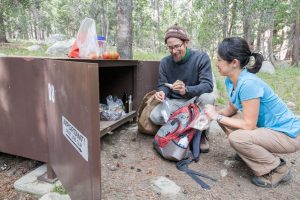YOSEMITE – Yosemite National Park and Yosemite Conservancy today announced the launch of KeepBearsWild.org, a new website to protect the park’s iconic black bears.
The website features the National Park Service’s first online bear tracker, information on ways for the public to help save bears, and eye-opening photography and videos not before available to the public.
“KeepBearsWild.org is an important way to raise awareness, appreciation and respect for Yosemite’s beloved black bears,” said Yosemite National Park Acting Superintendent Chip Jenkins. “Our message is simple: everyone can keep bears wild by driving slowly, storing food properly and staying at a safe distance when you see them.”
Yosemite Conservancy grants of more than $1.2 million since 1998 have funded a variety of bear-management tools, including the creation of KeepBearsWild.org.
 Conservancy support has also gone to improving monitoring and tracking technologies, purchasing and installing thousands of bear-proof food lockers, and funding research and educational programs. As a result of such programs, there has been a massive reduction in annual bear-related incidents in the park, from 1,584 in 1998 to fewer than 100 in 2016, says the Conservancy.
Conservancy support has also gone to improving monitoring and tracking technologies, purchasing and installing thousands of bear-proof food lockers, and funding research and educational programs. As a result of such programs, there has been a massive reduction in annual bear-related incidents in the park, from 1,584 in 1998 to fewer than 100 in 2016, says the Conservancy.
“People love to see bears, and protecting them is something we can all do,” said Yosemite Conservancy President Frank Dean. “There’s a dual benefit here of helping park managers to learn even more about bear habits to protect them and raising awareness among visitors about what they can do to save bears. These types of programs are made possible by the generosity of our donors.”
Since 2014, Yosemite’s bear biologists have benefited from previously unprecedented access to real-time spatial data of bears captured in the park and fitted with GPS collars. This high-resolution data that identifies the bear’s location has allowed park managers to better understand responses of bears to seasonal changes in the distribution of natural foods, as well as the lure of human food. Yosemite’s bear team has utilized this information to better strategize and manage park bears in near real-time and keep bears out of developed areas.
The movement patterns being observed over the past three years have inspired park managers to take this powerful information one step further. For the first time, delayed tracking of some bears will be shared with the public on the KeepBearsWild.org Bear Tracker. With the ultimate goal of keeping bears wild in Yosemite, managers are taking great care that sensitive data, such as den locations and exact coordinates, are not shared in real-time.
 To this end, delay intervals will not be made available to the public. In fall and winter months, delayed tracks will be removed to ensure the safety of these animals during hibernation. Historic tracks and blog post data will remain available on Bear Tracker for people to explore and interact with.
To this end, delay intervals will not be made available to the public. In fall and winter months, delayed tracks will be removed to ensure the safety of these animals during hibernation. Historic tracks and blog post data will remain available on Bear Tracker for people to explore and interact with.
As new bears are collared, their tracks may appear on Bear Tracker, while other tracks may disappear as collars are dropped, removed, or if data may jeopardize the safety of individual bears.
Yosemite Human-Bear Management Program experts will update perspectives regularly on the KeepBearsWild.org Bear Team Blog. KeepBearsWild.org also provides detailed information from bear managers on the most important part of saving bears in Yosemite: properly storing food at all times in bear-proof infrastructure. Visitors can more easily learn how to do their part to prevent bears from becoming food conditioned by properly using provided lockers or allowed wilderness food-storage containers to keep bears wild.
In addition, the new website provides a call to action for visitors to properly observe bears, informs on appropriate actions to take if you see a bear and where to report bear sightings, and provides insight into the bear management program and fun facts about Yosemite’s bears.
While great strides have been made in reducing food related human-bear incidents, each year vehicles strike dozens of black bears in Yosemite, including 28 in 2016. Another Yosemite Conservancy bear-protection grant in 2017 provided yearling-sized GPS collars to track and study three cubs orphaned when a car on Tioga Road struck their mother last year. The cubs spent months in the Lake Tahoe Wildlife Care Center (LTWC Inc.) and are currently hibernating in a den in Yosemite. Park managers have identified reduction of wildlife-vehicle collisions as a top priority for the future. You can do your part by obeying speed limits and staying alert while driving on park roads.
Other Yosemite Conservancy grants have provided for GPS collars and hand-held data-collection devices to replace older, outdated models, allowing wildlife managers to gather invaluable real-time information about park wildlife, and readily share this information to visitors in the field.
Yosemite National Park is home to between 300 and 500 American black bears. Despite their name, most of Yosemite’s black bears are actually brown in color. Black bears are incredibly strong, curious and intelligent animals. They are fast sprinters, agile climbers, excellent swimmers and quick learners with an extraordinary sense of smell — and a huge appetite. The average female bear weighs 150 pounds and males often exceed 300 pounds. The average lifespan is 18 years in the wild. Black bears naturally avoid humans, but when they learn to associate food with people, that behavior can change quickly, which is why vigilance and proper food storage are so important.
About Yosemite Conservancy
Through the support of donors, Yosemite Conservancy provides grants and support to Yosemite National Park to help preserve and protect Yosemite today and for future generations. Work funded by the Conservancy is visible throughout the park in trail rehabilitation, wildlife protection, and habitat restoration. The Conservancy is also dedicated to enhancing the visitor experience and providing a deeper connection to the park through outdoor programs, volunteering, wilderness services, and its bookstores. Thanks to dedicated supporters, the Conservancy has provided more than $113 million in grants to Yosemite National Park. Learn more at www.yosemiteconservancy.org or call 415-434-1782.




